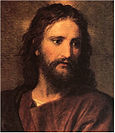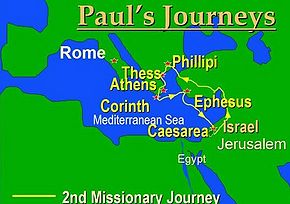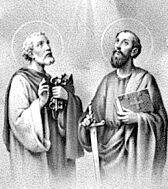Saint Paul
 From Conservapedia
From Conservapedia 
| |
| Christianity | |
|
Foundations Bible Christian Theology History and Traditions Important Figures | |

Saint Paul (Hebrew: שאול Shaul "asked [of God]") Apostle of the Gentiles, also known as Saul of Tarsus. Paul is the author of a major portion comprising the bulk of the New Testament commonly referred to as the Catholic Epistles of Paul.
Never having seen or met Jesus himself in the flesh, he was suddenly visited by Jesus while on his way to persecute his followers at Damascus. Paul saw a blinding white light and fell to the ground as Jesus talked to him asking Saul why he was persecuting him, then telling him to go into the city where he would be told what to do. Paul got up, but when he opened his eyes, he found he was blind. Being led by the hand into the city by the men who were with him, for three days Paul could not see and would not eat or drink. But a stranger named Ananias came to see him, a follower of Christ, having been led by God in a vision to where Paul was staying. Placing his hands upon Paul as God told him to do, Paul was cured as he acquired faith in Christ, and something like scales fell from his eyes. Paul became baptized that very day. (Acts 9:1-19). This incident is called the Road to Damascus experience.

St. Paul testified that he had been "a Hebrew of Hebrews; as to the law, a Pharisee; as to zeal, a persecutor of the church; as to righteousness which is in the Law, found blameless," (Philippians 3:5b-6) and a student of the esteemed rabbi Gamaliel (Acts 22:3) As such, he originally hated the Christians and took a lead in persecuting them: specifically, he was "in hearty agreement" with the stoning of saint Stephanus (Stephen). After conversion he undertook a series of missionary journeys to the gentiles. These were dedicated mainly to spreading a universal or catholic gospel - a gospel of grace that freed gentiles from the necessity of observing the Jewish Law, reportedly much to the scandal of the Church at Jerusalem headed by Peter, who heard his rebuke and acquiesced to God's anointing upon Paul.
Paul had an historic conflict with Peter, who initially felt that Christianity was meant only for Jewish people. Their conflict was resolved by a convening of early Christians in Jerusalem, and Paul's approach prevailed: Christianity was to be spread to the entire world, both Jewish and Gentile - a universal or catholic church.
Feastday: June 29.
Contents
- 1 Apostle of the Gentiles
- 2 Authorship of Epistles
- 3 Chronology and Timeline of Epistles
- 4 Last years
- 5 Iconography
- 6 See also
- 7 External links
- 8 References
- 9 Sources
Apostle of the Gentiles[edit]

Because the liberating effects of his message caused much unintended immorality and uncertainty among his gentile converts, many of whom promptly gave up their jobs and other commitments in expectation of the imminent Last Days, Paul wrote many letters to his various 'churches' expounding on the gospel of grace and on a wide variety of subjects, including the essential kerygma or preaching thrust of what was to become Christianity. He was also wrote on agape, or universal, unconditional compassion, as referred to at 1 Corinthians 13:1-13. Thirteen of these letters were subsequently incorporated into the New Testament: Romans, I Corinthians, II Corinthians, Galatians, Ephesians, Philippians, Colossians, I Thessalonians, II Thessalonians, I Timothy, II Timothy, Titus and Philemon.
Authorship of Epistles[edit]
Against the claim of inauthenticity in the Pauline epistles, Bp. Eusebius says of the 14 Pauline Epistles,
"Paul's fourteen epistles are well known and undisputed ... 3. Those great and truly divine men, I mean the apostles of Christ, were purified in their life, and were adorned with every virtue of the soul, but were uncultivated in speech. They were confident indeed in their trust in the divine and wonder-working power which was granted unto them by the Saviour, but they did not know how, nor did they attempt to proclaim the doctrines of their teacher in studied and artistic language, but employing only the demonstration of the divine Spirit, which worked with them, and the wonder-working power of Christ, which was displayed through them, they published the knowledge of the kingdom of heaven throughout the whole world, paying little attention to the composition of written works. 4. And this they did because they were assisted in their ministry by one greater than man. Paul, for instance, who surpassed them all in vigor of expression and in richness of thought, committed to writing no more than the briefest epistles, although he had innumerable mysterious matters to communicate, for he had attained even unto the sights of the third heaven, had been carried to the very paradise of God, and had been deemed worthy to hear unspeakable utterances there." [1]
Chronology and Timeline of Epistles[edit]
The Catholic Encyclopedia summarizes a likely timeline of major events in the life of St. Paul, especially his authorship of the Pauline Epistles: "In fixing as follows the chief dates in the life of Paul all certain or probable data seem to be satisfactorily taken into account: Conversion, 35; first visit to Jerusalem, 37; sojourn at Tarsus, 37-43; apostolate at Antioch, 43-44; second visit to Jerusalem, 44 or 45; first mission, 45-49; third visit to Jerusalem, 49 or 50; second mission, 50-53; (1 and 2 Thessalonians), 52; fourth visit to Jerusalem, 53; third mission, 53-57; (1 and 2 Corinthians; Galatians), 56; (Romans), 57; fifth visit to Jerusalem, arrest, 57; arrival of Festus, departure for Rome, 59; captivity at Rome, 60-62; (Philemon; Colossians; Ephesians; Philippians), 61; second period of activity, 62-66; (1 Timothy; Titus), second arrest, 66; (2 Timothy), martyrdom, 67. (See Turner, "Chronology of the New Testament" in Hastings, "Dict. of the Bible" Hönicke, "Die Chronologie des Lebens des Ap. Paulus", Leipzig, 1903.)"[2]
| Date | Event in St. Paul's Life |
|---|---|
| 35 A.D. | Conversion |
| 37 | First Visit to Jerusalem |
| 37-43 | Sojourn at Tarsus |
| 43-44 | Apostolate at Antioch |
| 44-45 | Second visit to Jerusalem |
| 45-49 | First Mission |
| 49-50 | Council of Jerusalem |
| 50-53 | Second Mission |
| 52 | 1 and 2 Thessalonians |
| 53 | Fourth Visit to Jerusalem |
| 53-57 | Third Mission |
| 56 | 1 and 2 Corinthians |
| 56 | Galatians |
| 57 | Romans |
| 57 | Fifth Visit to Jerusalem |
| 57 | Arrest |
| 59 | Arrival of Festus |
| 59 | Departure to Rome |
| 60-62 | Captivity at Rome |
| 61 | Philemon, Colossians. |
| 61 | Ephesians, Philippians. |
| 62-66 | Second Period of Activity |
| 66 | First Epistle to Timothy; Titus. |
| 66 | Second Arrest |
| 67 | Second Epistle to Timothy |
| 67 | Together with Saint Peter. |
| 67 A.D. | Martyrdom under Nero. |
Last years[edit]

During the last years he intended to visit Spain (Romans 15:24), Lycus, Laodicea, Collusus and Hierapolis. He also went to Crete, Ephesus and Macedonia.
Saint Paul was arrested (Acts 21:27- 28:31); he was accused of bringing Gentiles into the temple. Paul appealed to Caesar (his right as a citizen) and he was sent to Rome for a Roman trial. The Biblical account leaves off before the trial takes place. St. Paul was brought to Rome, but Nero was the Emperor and after the Rome fire where he blamed the Christians to deflect attention from himself, he was an ardent persecutor of the Christians, killing many. St. Paul was martyred near Rome at the Aquae Silviae. St. Dionysios the Corinthian says that St. Paul and St. Peter were martyred at “about the same time.” It is believed that St. Paul died aged 68 having served the Lord for some 35 years.[3]
St. Paul was a profound religious thinker; he has had an important formative influence in the development of Christianity.
Iconography[edit]
In art, St Paul is traditionally depicted in red and green robes, wearing a beard and holding a sword. He often appears alongside St Peter.

See also[edit]
- Saint Peter
- Roman Catholic Church
- The Twelve Apostles
- Christian Saints Gallery
- Cosmic Christ
External links[edit]
- PETER AND PAUL APOSTLES AND MARTYRS (29 JUN 64)
- Apostles
- Historical Evidence and the Apostle Paul's Shipwreck
References[edit]
- ↑ Ecclesiastical History, Bishop Eusebius, Book III, Cap. III. https://www.newadvent.org/fathers/250103.htm
- ↑ 1911 Catholic Encyclopedia, "St. Paul the Apostle". https://www.newadvent.org/cathen/11567b.htm
- ↑ St. Paul
Sources[edit]
- Cruden, A., Complete Concordance to the Old and New Testaments (Lutterworth, 1930)
- Cross, C., Who Was Jesus? (Hodder & Stoughton, 1970)
- The Holy Bible (King James Version)
- James, M. R., The Apocryphal New Testament (Clarendon, Oxford, 1953)
- The New English Bible (Oxford & Cambridge University Presses, 1970)
- The New Jerusalem Bible (Darton, Longman & Todd, 1990)
- Lemesurier, P., The Armageddon Script (Element Books, 1981)
- Peake, A.S., Commentary on the Bible (Nelson, 1962)
- Schonfield, H. J., The Passover Plot (Hutchinson, 1965)
- Schonfield, H. J., The Pentecost Revolution (Macdonald, 1974)
- Schonfield, H.J., Those Incredible Christians (Bernard Geis, New York, 1968)
- Vermes, G., Jesus the Jew (Collins, 1973)
- Young, R., Analytical Concordance to the Holy Bible (Lutterworth, 1939)
| |||||||||||
| ||||||||||||||
Categories: [Saints] [Martyrs] [Early Christians] [Theologians] [Christianity] [Bible] [Missionaries] [Christian Authors] [Roman Authors] [Christians]
↧ Download as ZWI file | Last modified: 02/05/2023 18:38:53 | 54 views
☰ Source: https://www.conservapedia.com/Saint_Paul | License: CC BY-SA 3.0
 ZWI signed:
ZWI signed: KSF
KSF